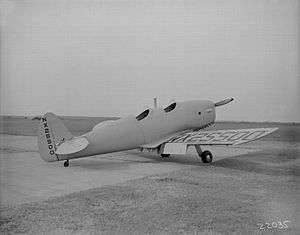St. Louis PT-LM-4
| PT-LM-4 | |
|---|---|
 | |
| PT-LM-4 | |
| Role | Primary trainer |
| National origin | United States |
| Manufacturer | St. Louis Aircraft Corporation |
| First flight | 1940 |
|
| |
The St. Louis PT-LM-4 was a primary trainer design for use in the Civilian Pilot Training Program of World War II.
Design
The PT-LM-4 was a low-wing, open cockpit, tandem seat, trainer with conventional landing gear, powered by a 180 hp (134 kW) Ranger 6-440C-3 engine. The fuselage was constructed of welded steel tubing with aluminum skins. The wings used aluminum construction with aircraft fabric covering. Fairchild won the training contract, with St. Louis Aircraft Company building licensed versions of the PT-19 instead.[1]
Specifications (PT-LM-4)
Data from Skyways
General characteristics
- Crew: 2
- Length: 24 ft 9 in (7.54 m)
- Wingspan: 30 ft (9.1 m)
- Height: 7 ft 10 in (2.39 m)
- Wing area: 157 sq ft (14.6 m2)
- Gross weight: 2,012 lb (913 kg)
- Powerplant: 1 × Ranger 6-440C-3 inline piston engine, 180 hp (130 kW)
Performance
- Maximum speed: 119 kn; 220 km/h (137 mph)
- Cruise speed: 109 kn; 201 km/h (125 mph)
- Service ceiling: 18,000 ft (5,500 m)
- Rate of climb: 1,000 ft/min (5.1 m/s)
See also
- Aircraft of comparable role, configuration and era
References
- ↑ "The St. Louis Aircraft Corporation". Skyways. October 1995.
This article is issued from Wikipedia - version of the 6/23/2015. The text is available under the Creative Commons Attribution/Share Alike but additional terms may apply for the media files.